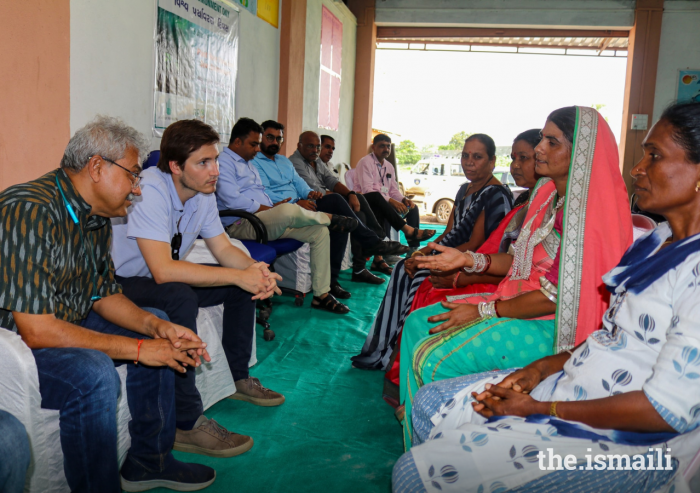 (From L to R): Chairman Ratan Tata of the Sir Dorabji Tata Trust, Minister Chandresh Kumari Katoch, Prime Minister Manmohan Singh, and Mawlana Hazar Imam inaugurate the restoration of Humayun's Tomb on 18 September 2013. AKDN / Gary Otte
(From L to R): Chairman Ratan Tata of the Sir Dorabji Tata Trust, Minister Chandresh Kumari Katoch, Prime Minister Manmohan Singh, and Mawlana Hazar Imam inaugurate the restoration of Humayun's Tomb on 18 September 2013. AKDN / Gary OtteDelhi, 18 September 2013 – The restoration of the 16th century garden tomb of the Mughal emperor Humayun was inaugurated in Delhi today. Mawlana Hazar Imam, the Prime Minister of India, Dr Manmohan Singh, the Minister of Culture, Chandresh Kumari Katoch, and Chairman Ratan Tata of the Sir Dorabji Tata Trust presided over the ceremony together, a reflection of the public-private partnership that was pivotal to the project's success.
A precursor to the Taj Mahal and considered “the jewel of Mughal architecture”, Humayun's Tomb had, by the latter part of the 20th century, fallen into severe disrepair, with cracked masonry, broken stonework and worn out gardens. In 1997, as a gift to India on the occasion of the 50th anniversary of the country's independence, Mawlana Hazar Imam asked the Aga Khan Trust for Culture to undertake the restoration of the gardens surrounding the tomb, which they completed in 2004.
“I recall that, in November 2004, speaking at this very spot on the occasion of the presentation of the Aga Khan Award for Architecture, I had expressed the hope that a public-private partnership could be created to maintain and restore historic monuments,” said Prime Minister Singh in his speech at the inauguration ceremony. He had also called for India “to evolve a more holistic understanding of conservation that combines our preservation efforts with the social and economic needs of the communities that surround these historic monuments.”
“I think we have found a good model in the public-private partnership that has restored this great monument to its earlier glory,” he said.
Lauding the Indian Prime Minister's foresight, Mawlana Hazar Imam said “it was he who first recommended to the Aga Khan Trust for Culture that projects like this should be built on public-private partnerships. We heeded his suggestion, and today the great majority of the 20 similar projects we have undertaken are founded on public-private agreements.”
Humayun's Tomb does not stand in isolation. The builders of this majestic monument situated it in close proximity to the dargah of Hazrat Nizamuddin Auliya (d. 1325), a famous and highly influential sufi shaikh, whose mausoleum complex would later encompass the tombs of other prominent sufis such as Amir Khusrow, as well as Emperor Shah Jahan's daughter, Jahanara Begum, and the renowned poet Mirza Ghalib. The settlement surrounding the dargah is said to have remained continuously inhabited since Nizamuddin's lifetime, and the site is visited by thousands of people – Muslims, Hindus, Christians and adherents of other faiths – each week.
The mausoleum of the second Mughal Emperor was “the first garden-tomb complex on the Indian subcontinent,” recalled Hazar Imam. He underscored its continued importance, “its power to fascinate, to teach and to inspire us, nearly half a millennium after it was originally built.”
The success of the Humayun's Tomb garden restoration demonstrated that heritage projects could be sustainable and could also serve as catalysts for the revitalisation of historic cities. Interest grew in the possibility of expanding the scope of restoration, and in creating a model that could be replicated elsewhere in the country.
In 2007 therefore, building further upon the pledge made by Mawlana Hazar Imam ten years prior, and responding to the Prime Minister's call for the use of public-private partnerships as a model for sustainable cultural development, the AKTC and the Archaeological Survey of India partnered with several government agencies and co-funding partners – including the Sir Dorabji Tata Trust – on an Urban Renewal Initiative. The initiative broadened the scope of the conservation project significantly, incorporating Humayun's Tomb, the Nizamuddin Dargah, the Sundar Nursery, some 30 monuments and an extensive landscaping programme that resulted in the creation of a city park. The project also incorporated significant quality of life improvements for the residents of the surrounding Hazrat Nizamuddin Basti.
Over the next five years, master craftsmen spent some 200,000 work days on the project. Restoring Humayun's Tomb to the original design of its Mughal builders required removing a million kilograms of concrete and thousands of square metres of cement – the legacy of past repair attempts. But the project's craft-based approach to conservation also resulted in a model for reviving fast-disappearing skills that could be employed in other projects, while simultaneously creating employment.
 Mawlana Hazar Imam with Indian Prime Minister Manmohan Singh at the inauguration of the restoration of Humayun's Tomb in Delhi. AKDN / Gary Otte
Mawlana Hazar Imam with Indian Prime Minister Manmohan Singh at the inauguration of the restoration of Humayun's Tomb in Delhi. AKDN / Gary OttePraising the public-private partnership initiative, Prime Minister Singh said, “I would like to congratulate the Aga Khan Trust for Culture, the Archaeological Survey of India and the Sir Dorabji Tata Trust on the success of this endeavour, which has spared no resources and no effort to bring our systems at par with the best in the world and provide a model for conservation to the world.”
“I would also like to personally thank His Highness the Aga Khan for his commitment to revitalising historic centres, here in India and abroad,” he continued. “We are fortunate to count him as a great friend of Indian heritage and I have no doubt that we will be able to continue this rich partnership into the future.”










